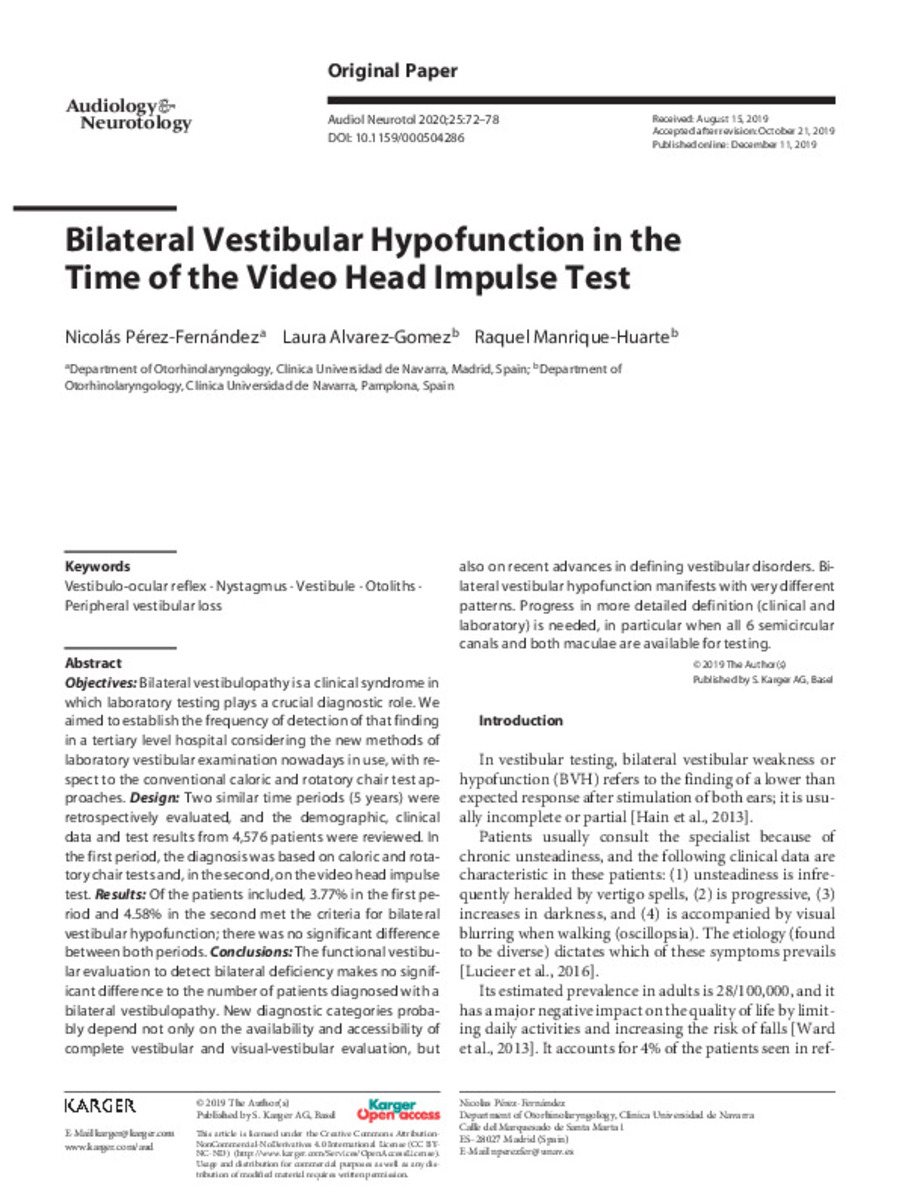Full metadata record
| DC Field | Value | Language |
|---|---|---|
| dc.creator | Perez-Fernandez, N. (Nicolás) | - |
| dc.creator | Alvarez-Gomez, L. (Laura) | - |
| dc.creator | Manrique-Huarte, R. (Raquel) | - |
| dc.date.accessioned | 2023-02-23T08:20:47Z | - |
| dc.date.available | 2023-02-23T08:20:47Z | - |
| dc.date.issued | 2020 | - |
| dc.identifier.citation | Perez-Fernandez, N. (Nicolás); Alvarez-Gomez, L. (Laura); Manrique-Huarte, R. (Raquel). "Bilateral Vestibular Hypofunction in the Time of the Video Head Impulse Test". Audiology and Neurotology. 21 (1-2), 2020, 72 - 78 | es |
| dc.identifier.uri | https://hdl.handle.net/10171/65532 | - |
| dc.description.abstract | Objectives: Bilateral vestibulopathy is a clinical syndrome in which laboratory testing plays a crucial diagnostic role. We aimed to establish the frequency of detection of that finding in a tertiary level hospital considering the new methods of laboratory vestibular examination nowadays in use, with respect to the conventional caloric and rotatory chair test approaches. Design: Two similar time periods (5 years) were retrospectively evaluated, and the demographic, clinical data and test results from 4,576 patients were reviewed. In the first period, the diagnosis was based on caloric and rotatory chair tests and, in the second, on the video head impulse test. Results: Of the patients included, 3.77% in the first period and 4.58% in the second met the criteria for bilateral vestibular hypofunction; there was no significant difference between both periods. Conclusions: The functional vestibular evaluation to detect bilateral deficiency makes no significant difference to the number of patients diagnosed with a bilateral vestibulopathy. New diagnostic categories probably depend not only on the availability and accessibility of complete vestibular and visual-vestibular evaluation, but also on recent advances in defining vestibular disorders. Bilateral vestibular hypofunction manifests with very different patterns. Progress in more detailed definition (clinical and laboratory) is needed, in particular when all 6 semicircular canals and both maculae are available for testing. | es_ES |
| dc.description.sponsorship | The authors disclose no possible conflicts of interest. There was no external support or financial involvement in the study | es_ES |
| dc.language.iso | spa | es_ES |
| dc.rights | info:eu-repo/semantics/openAccess | es_ES |
| dc.subject | Vestibulo-ocular reflex | es_ES |
| dc.subject | Nystagmus | es_ES |
| dc.subject | Vestibule | es_ES |
| dc.subject | Otoliths | es_ES |
| dc.subject | Peripheral vestibular loss | es_ES |
| dc.title | Bilateral Vestibular Hypofunction in the Time of the Video Head Impulse Test | es_ES |
| dc.type | info:eu-repo/semantics/article | es_ES |
| dc.publisher.place | Basel | es_ES |
| dc.description.note | This article is licensed under the Creative Commons AttributionNonCommercial-NoDerivatives 4.0 International License (CC BYNC-ND) (http://www.karger.com/Services/OpenAccessLicense). Usage and distribution for commercial purposes as well as any distribution of modified material requires written permission. | es_ES |
| dc.identifier.doi | 10.1159/000504286 | - |
| dadun.citation.endingPage | 78 | es_ES |
| dadun.citation.number | 1-2 | es_ES |
| dadun.citation.publicationName | Audiology and Neurotology | es_ES |
| dadun.citation.startingPage | 72 | es_ES |
| dadun.citation.volume | 21 | es_ES |
Files in This Item:
Statistics and impact
Items in Dadun are protected by copyright, with all rights reserved, unless otherwise indicated.






